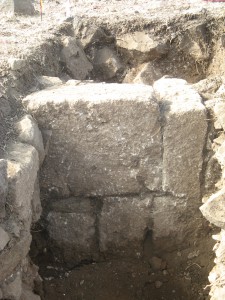When Jason announced to my square two weeks ago that we had hit bedrock, I know my face fell. This is all? I thought. We had reached no conclusions about our square, except that it was some kind of space between two walls, occupied during the Byzantine period. We had no idea what function it served (was it a trash heap? a pottery shop? an alleyway?), how it related to the rest of the site (did the walls directly connect to the walls in the square next to us, excavated in 2010?), or how the artifacts that we had found connected with each other (what on earth does a goat tooth have to do with a bell and a spindle whorl?). We had found a few cool things, but no answers to the questions with which we had begun.
The cliche researcher frustratedly looking for the “big picture” among the details, I had searched for answers and instead found more questions. Over the last two weeks, however, I have had plenty of time to ponder what the site may have gained by opening Square O16. O16 was experimental from the beginning, the first square in a phase that will increasingly focus on the area uphill from the temple. Perhaps, then, it was our square’s job to identify questions rather than come up with answers. What was the relationship between seemingly mundane and secular area in which we were digging and the temple, for example? How connected was the region uphill from the temple to the temple itself, especially in the Byzantine period? Were there any structures uphill from the temple before the Byzantine period? How densely populated was this region during the Byzantine period? We probably will not find out the answers to these for many years, if at all. But they help us understand what our goals will be during the coming years.
I was fortunate enough to begin work answering these questions when I was sent to help Greg Stoehr, Omrit’s survey archaeologist, to dig his probe near the north wadi. Perhaps the most exciting feature of this square was the Roman wall on the south side. This wall, which I modestly termed “Lydia’s Second Wall,” seems to have been a significant one, several courses deep, very thick, and constructed of finely cut limestone ashlars. In addition to identifying the north wadi as an important (perhaps holy?) aspect of the site, the wall implies that Omrit was indeed more than just a temple site, not only in Byzantine times but also in Roman.
Once again, however, I found myself with more questions than answers. Poorly constructed Byzantine walls were tacked onto the fine Roman wall on the north side of the trench, forcing me to wonder how the Byzantines interacted with earlier structures around them. Would the south wall have retained its original purpose or significance in the Byzantine period? More generally, what was the role of the aging temple in the life of the Byzantines? How would the Christian Byzantines have felt about the presence of a pagan temple so close to their homes? (Or, how Christian were the Byzantines at this site, if at all?)
Perhaps, after all, archaeology can dig up only more questions. Yet these questions are no less important when unanswerable, and every new question helps us reshape our ideas of the past and identify the most important aspects of the lives of the ancients.
After a tour de force of Jerusalem and a long plane ride, I am finally back in the States, though I am missing Kefar Szold, Omrit, and all my fellow Omritians already. Thank you so much to everyone who helped make my time in Israel so wonderful, and especially to Professor Rubin for bringing us humble undergrads along with him to Omrit.

